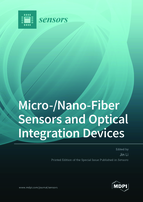Micro-/Nano-Fiber Sensors and Optical Integration Devices
A special issue of Sensors (ISSN 1424-8220). This special issue belongs to the section "Sensor Materials".
Deadline for manuscript submissions: closed (20 June 2022) | Viewed by 23645
Special Issue Editor
Interests: Optical fiber sensors; Microfiber sensors; Integration optical devices; Gas sensing based on semiconductor materials
Special Issues, Collections and Topics in MDPI journals
Special Issue Information
Dear Colleagues,
Because of their strong surface evanescent field, micro-/nano-fibers have been used to develop optical sensors and modulation devices with a high performance and integration. In recent years, they have become an important branch of optical fiber optics and novel sensors, and have received extensive attention from researchers from all over the world. On the one hand, the sensing and optical properties of micro/-nano-fiber devices can be optimized by introducing different micro/nano-structures through micro-/nano-processing technology (femtosecond laser processing, electron beam etching, ion beam engraving, and chemical etching) or through the functionalization of new nanomaterials (film coating and particle doping) in order to achieve high selectivity detection for the desired targets. On the other hand, their tight confinement effect for light based on the high evanescent field coupling efficiency is also conducive to the integration of free-standing optical fibers with typical planar micro-/nano-structures on silicon substrates, making them a promising candidate for exploring nanophotonic integrated devices.
Dr. Jin Li
Guest Editor
Manuscript Submission Information
Manuscripts should be submitted online at www.mdpi.com by registering and logging in to this website. Once you are registered, click here to go to the submission form. Manuscripts can be submitted until the deadline. All submissions that pass pre-check are peer-reviewed. Accepted papers will be published continuously in the journal (as soon as accepted) and will be listed together on the special issue website. Research articles, review articles as well as short communications are invited. For planned papers, a title and short abstract (about 100 words) can be sent to the Editorial Office for announcement on this website.
Submitted manuscripts should not have been published previously, nor be under consideration for publication elsewhere (except conference proceedings papers). All manuscripts are thoroughly refereed through a single-blind peer-review process. A guide for authors and other relevant information for submission of manuscripts is available on the Instructions for Authors page. Sensors is an international peer-reviewed open access semimonthly journal published by MDPI.
Please visit the Instructions for Authors page before submitting a manuscript. The Article Processing Charge (APC) for publication in this open access journal is 2600 CHF (Swiss Francs). Submitted papers should be well formatted and use good English. Authors may use MDPI's English editing service prior to publication or during author revisions.
Keywords
- integration optics
- optical fiber sensors
- microfiber
- nanofiber







